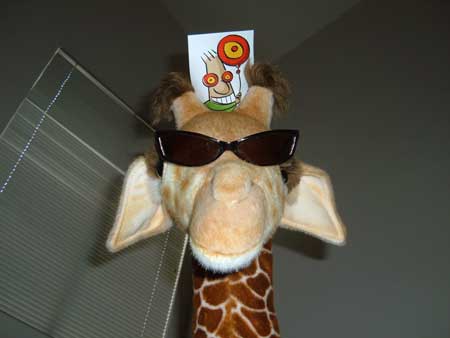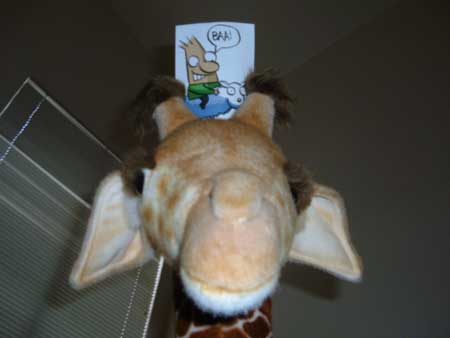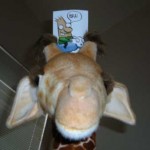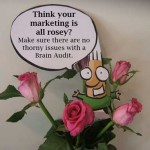The Brain Audit Book makes its way to the UK, India, USA and The Netherlands.

The Brain Audit Photo above is called, “Can’t See The Forest For The Trees!”

And this one is called, “Air’s Thin Up Here.”
Dwight Schwersensky, California, USA
——————————

“If I had to keep just one book out of my entire library, I would keep Sean D’Souza’s Brain Audit.”
Ankesh Kothari, Mumbai, India
——————————

David Rothwell at hockey practice with Charlie and some light reading…We’re frowning because the sun’s in our eyes!
David Rothwell, UK
——————————

Brain Audit Book photo. Since New Zealand is the land of the kazillion sheep and we have two border collies…I thought why not put the two together? 😉
Erwin van den Boogaard, The Netherlands
P.S. Please tell Cuatro to relax, they don’t bite – at least not yet 😉
——————————
>>Click to see the other Brain Audit Book Photos

2007 World Skating Champion: Miki Ando
When you look around you and see talented people you may run into a common misconception.
You may believe that those considered ‘talented’ or ‘creative’ require less practice.
Makes sense, huh?
If you’re already talented, where’s the need for practice?
You already have what it takes.
Your brain is genetically engineered towards your talent.
You should be coasting downhill, while the others struggle.
Yet the evidence all around you, points to the exact opposite situation.
The top athletes in the world practice long hours.
The top artists in the world seem to be stuck to their palettes.
The best speakers go over their material, time after time, after time.
The best figure skaters do their routines hypnotically.
In fact, when research was done on the top figure skaters, here’s what the researchers found.
They found that the mark of the top skater is the ability to do their spins and jumps.
And that the absolute crème da la crème skaters did more jumps and spins, when practicing.
The researchers found that the slightly lower-ranked skaters did just a little less practice.
And took more breaks in between their jumps and spins.
Less practice, eh?
And yet we strongly believe that talent is inborn.
Because if talent were indeed inborn, then where’s the need to practice?
Where’s the need to do yet another jump and turn?
Surely even at the highest level of sport, one figure skater would be so overloaded with talent, that it would be impossible for others to catch up. Surely it would be impossible, no matter how many hours of practice their competition puts in.
Talent or creativity is the result of many, many hours of frustrating practice.
Because when we have courses, like say Article Writing for instance, I can tell you who’ll be the star of the course.
I can tell you within days of the course beginning, who’ll write better articles than anyone else.
I can tell you, even without knowing that person’s background, or capability, or any so-called talent.
I can tell you based on momentum.
The ones who consistently write better, faster, and with more panache are those who practice.
Day in, day out. Week in, week out.
The momentum builds on itself.
Suddenly patterns emerge.
Suddenly the achievement is higher.
Suddenly the pats on the back increase.
But is momentum alone enough to create a factor of skill?
Obviously not.
However, it is one of the most critical factors, as compared to everything else.
Because whom would you rather believe?
The perception of the average person on the street—who believes in inborn talent?
Or the figure skater doing yet one more practice jump and turn?

People believe they’re good at drawing…or bad at drawing
How this this crazy notion come about? How did we get it into our heads that we were good or bad at something? I’ll tell you how.
Let’s take drawing, because most people simply can’t draw…
So why can’t they draw? Is it because they’re not talented? Let’s see, shall we?
Imagine a skill you’re good at: Like walking around a banana peel, for instance.
Imagine someone put five banana peels in your path.
Or ten. Or twenty-five. Or even fifty.
Would you be able to avoid the banana peel, and walk right along?
Silly question, eh? But what’s the banana peel got to do with your brain?
The brain recognised the danger of the peel. It recognised that the peel could create damage.
You could slip; fall; hurt yourself; even die.
So the brain pays attention. It prevents you from stepping on the peel in the future.
Drawing, on the other hand, doesn’t cause you to slip; fall or hurt yourself.
So your brain has no need to pay attention.
Yet, imagine you did a drawing as a child.
Imagine that every time you did that drawing you were slapped.
Not just slapped hard across the face. But ridiculed. And punished.
What are the chances you’d become really outstanding at drawing?
Pretty slim, huh?
So let’s take the exact opposite. Let’s say you did the drawing, and your mother was really excited. She showed it to everyone. She told you (and told the world) how talented you were. She brought you more crayons. More paper. More encouragement. And despite being ‘lousy’ at drawing, she felt no intimidation when showing you—a little child—how to draw.
And so the stirrings of talent begin.
You become talented.
You draw more.
You use drawing as a weapon to get attention.
You spend more time, understanding the medium and patterns better.
You get more attention. You draw even more. And the attention feeds on itself, resulting in more effort, more training.
And voila, you’re an artist.
You see it’s stupidity that causes us to believe in talent.
Talent is nothing but a seed, well watered.
Which is why most of us have a ‘talent’ to speak almost one language.
Most of us have a ‘talent’ to press door bells, and speak on phones.
Most of us have a ‘talent’ to recite and write our alphabet from one end to the other.
Which brings us back to drawing
Surely drawing is a lot more complex than reciting and writing the alphabet.
You think so? Tell that to a three-year old child.
Watch as she struggles with just the letter A. Or B. Or the combination of A, B and C.
So what makes her talent grow?
It’s the banana peel of life.
Her parents know that that child will ‘slip and fall’ if she doesn’t learn her alphabet.
So they make the alphabet fun. They show the child a cat. And say the letter C.
They show the child a ball, and you guessed it, it’s the letter B.
And soon, every child becomes a genius at the alphabet.
And you know what, if you are a genius at the alphabet, I can indeed teach you how to draw using NOTHING but the alphabet.
And could you then become a genius at drawing?
Hmmm…food for thought, eh?
So what are your questions? Because as you can tell, this is indeed going to be a long, long series.














